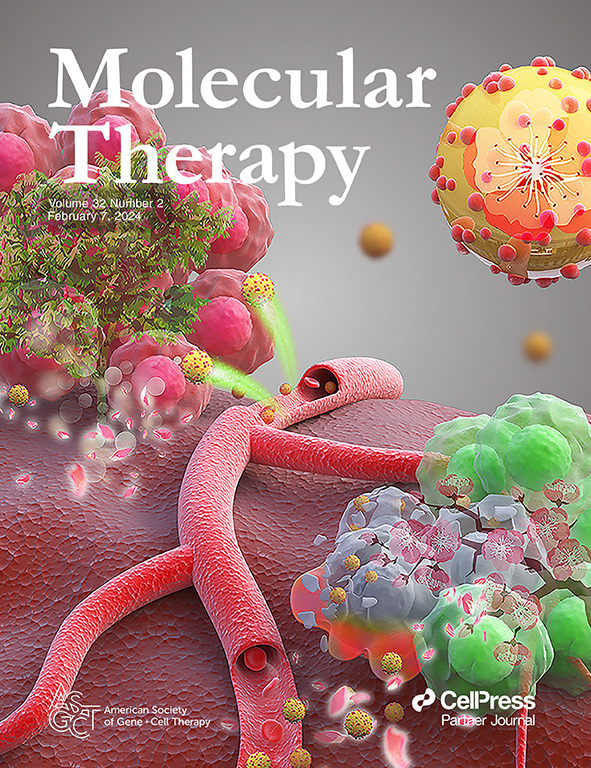aav介导的外显子跳跃治疗Usher综合征,2A型。
IF 12
1区 医学
Q1 BIOTECHNOLOGY & APPLIED MICROBIOLOGY
引用次数: 0
摘要
Usher综合征会导致视力、听力和平衡能力的丧失。临床有四种亚型,USH1到4,它们与对视网膜感光细胞和内耳感觉毛细胞的结构、功能和存活重要的基因突变有关。编码促Usher蛋白的USH2A基因的基因突变是世界范围内导致Usher综合征最常见的原因,其中c.2299delG (p.Glu767Serfs*21)是最常见的致病变异。一种用于USH2A c.2299delG的反义寡核苷酸(ASO), QR-421a,旨在绕过突变,已经在1/2期临床试验中显示出希望(Dulla等人,2021)。虽然最近开发的化学方法可以延长ASO的半衰期,但可能需要反复注射ASO才能达到长期的效果。为了克服这一限制,我们筛选了新的USH2A外显子13跳跃子和20个AAV衣壳,目的是开发一种矢量化ASO外显子跳跃策略。优化载体和跳跃载体在携带USH2A c.2299delG突变的人干细胞的内耳和视网膜类器官中进行了评估。数据显示致病外显子的跳跃增强,为使用单一局部注射治疗USH2A患者提供了一种替代策略,可以防止视力和听力损失的进展。本文章由计算机程序翻译,如有差异,请以英文原文为准。
AAV-Mediated Exon Skipping Therapy for Usher Syndrome, Type 2A.
Usher syndrome can cause loss of vision, hearing and balance. There are four clinical subtypes, USH1 through 4, which are associated with mutations in genes important for structure, function and survival of photoreceptor cells in the retina and sensory hair cells in the inner ear. Genetic mutations in the USH2A gene, which encodes usherin protein, are the most common cause of Usher syndrome worldwide, with c.2299delG (p.Glu767Serfs*21) being the most frequent pathogenic variant. An investigational antisense oligonucleotide (ASO) for USH2A c.2299delG, QR-421a, designed to bypass the mutation, has already shown promise in Phase 1/2 clinical trials (Dulla et al., 2021). While recently developed chemistry provides longer ASO half-lives, repeated injection of ASOs may be required to provide long-term efficiency. To overcome this limitation, we screened novel USH2A exon 13 skippers and 20 AAV capsids with the goal of developing a vectorized ASO exon skipping strategy. Optimized vectors and skippers were evaluated in inner ear and retinal organoids derived from human stem cell lines bearing the USH2A c.2299delG mutation. The data revealed enhanced skipping of the pathogenic exon, offering an alternative strategy for treatment of USH2A patients using a single local injection which may prevent progression of vision and hearing loss.
求助全文
通过发布文献求助,成功后即可免费获取论文全文。
去求助
来源期刊

Molecular Therapy
医学-生物工程与应用微生物
CiteScore
19.20
自引率
3.20%
发文量
357
审稿时长
3 months
期刊介绍:
Molecular Therapy is the leading journal for research in gene transfer, vector development, stem cell manipulation, and therapeutic interventions. It covers a broad spectrum of topics including genetic and acquired disease correction, vaccine development, pre-clinical validation, safety/efficacy studies, and clinical trials. With a focus on advancing genetics, medicine, and biotechnology, Molecular Therapy publishes peer-reviewed research, reviews, and commentaries to showcase the latest advancements in the field. With an impressive impact factor of 12.4 in 2022, it continues to attract top-tier contributions.
 求助内容:
求助内容: 应助结果提醒方式:
应助结果提醒方式:


